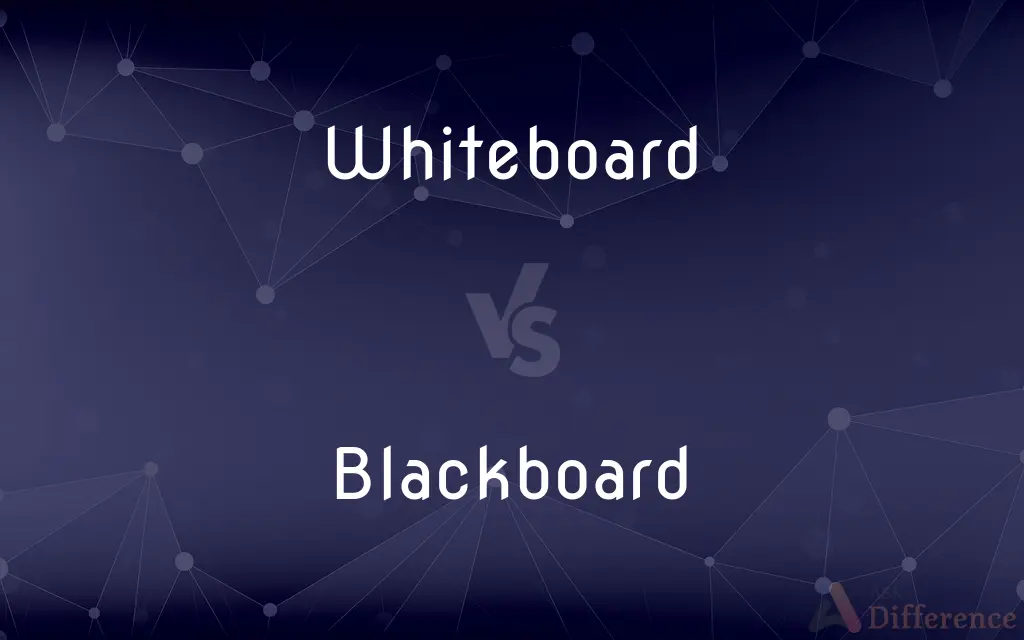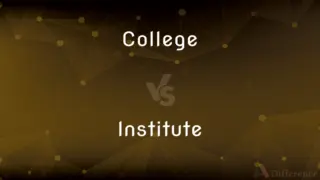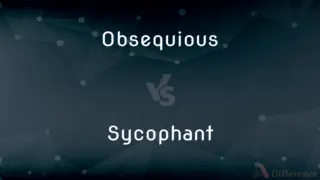Whiteboard vs. Blackboard — What's the Difference?
By Urooj Arif & Fiza Rafique — Updated on April 17, 2024
Whiteboards, featuring a smooth, white surface for non-permanent markers, offer easy cleanup and less dust; blackboards, with a dark, rough surface for chalk, are traditional but can be messier.

Difference Between Whiteboard and Blackboard
Table of Contents
ADVERTISEMENT
Key Differences
Whiteboards are typically made of materials like melamine, porcelain, or glass, providing a sleek surface that’s ideal for dry erase markers. Whereas, blackboards are often made of a darker slate or painted surface that requires chalk, giving them a distinct texture and appearance.
Whiteboards have gained popularity in modern classrooms and offices for their reusability and less dusty nature. On the other hand, blackboards have been used for centuries but can create a lot of chalk dust, which may be problematic for those with respiratory issues.
The use of whiteboards allows for vibrant color usage and high visibility, which can enhance learning and presentation. Conversely, blackboards offer a traditional aesthetic that some prefer for artistic or stylistic reasons, though they are limited to lighter colored chalk for visibility.
Whiteboards are easier to clean, typically requiring just a swipe with a dry cloth or a special eraser. In contrast, blackboards may require water or a damp cloth to thoroughly remove chalk residue, which can be more labor-intensive.
Whiteboards are often more reflective, which can sometimes cause glare in brightly lit environments. However, blackboards absorb light due to their darker color, reducing glare but sometimes making them harder to read from a distance.
ADVERTISEMENT
Comparison Chart
Surface Material
Melamine, porcelain, glass
Slate, painted wood or concrete
Writing Instrument
Dry erase markers
Chalk
Cleaning
Dry eraser or cloth
Damp cloth, sometimes needing water
Dust Generation
Minimal
High
Visual Effect and Visibility
High visibility, can cause glare
Lower visibility, no glare
Compare with Definitions
Whiteboard
Used in modern educational and business settings for easy rewriting.
During the meeting, ideas were jotted down on the whiteboard for everyone to see.
Blackboard
A dark surface used for writing with chalk.
The professor chalked up the day's lecture notes on the old blackboard.
Whiteboard
Reusable and easy to clean.
After the session, cleaning the whiteboard took just a moment.
Blackboard
Traditional tool in educational settings, known for its rustic feel.
The vintage classroom was equipped with a large blackboard, adding to its charm.
Whiteboard
Suitable for colorful presentations.
The use of different colored markers on the whiteboard made the presentation vibrant and engaging.
Blackboard
Produces dust, which can be an allergen or irritant.
The old blackboard’s chalk dust aggravated her allergies, making teaching a challenge.
Whiteboard
Reflective surface sometimes causes issues with overhead lighting.
They had to adjust the room’s lighting because the glare on the whiteboard made it hard to read.
Blackboard
Requires regular cleaning with a wet cloth to maintain clarity.
At the end of class, the teacher cleaned the dusty blackboard.
Whiteboard
A smooth, white surface for writing on with dry erase markers.
The teacher used a whiteboard to illustrate the math problem clearly.
Blackboard
Commonly used for artistic purposes due to texture.
The artist used the blackboard at the café to create a detailed menu display.
Whiteboard
A collaborative tool allowing several users to write and draw on the same shared display.
Blackboard
A blackboard (also known as a chalkboard) is a reusable writing surface on which text or drawings are made with sticks of calcium sulphate or calcium carbonate, known, when used for this purpose, as chalk. Blackboards were originally made of smooth, thin sheets of black or dark grey slate stone.
Whiteboard
A whiteboard (also known by the terms marker board, dry-erase board, dry-wipe board, and pen-board) is a glossy, usually white surface for making nonpermanent markings (an evolved version of the blackboard). Whiteboards are analogous to blackboards, but with a smoother surface allowing rapid marking and erasing of markings on their surface.
Blackboard
A large board with a smooth dark surface attached to a wall or supported on an easel and used by teachers in schools for writing on with chalk.
Whiteboard
A panel covered with white, glossy plastic for writing on with erasable markers. Also called dry erase board.
Blackboard
A smooth, hard, dark-colored panel for writing on with chalk.
Whiteboard
A writing board finished with a hard white material, which can be written upon using special non-permanent markers and subsequently wiped clean.
Blackboard
A large flat surface, finished with black slate or a similar material, that can be written upon with chalk and subsequently erased; a chalkboard.
Blackboard
To use a blackboard to assist in an informal discussion.
Blackboard
A broad board painted black, or any black surface on which writing, drawing, or the working of mathematical problems can be done with chalk or crayons. It is much used in schools. In late 20th century similar boards of a green slate as well as some colored white became common; wrioting on the slate bioards may be done with chalk, but writing on the white boards is done with colored pens, such as grease pens, which leaves a trace that can be easily erased. The newer boards, usualy called chalkboards are nevertheless still sometimes referred to as blackboards.
Blackboard
Sheet of slate; for writing with chalk
Common Curiosities
What is a blackboard?
A blackboard is a rougher, typically dark-colored surface used for writing with chalk.
How do you clean a whiteboard?
Simply wipe it with a dry eraser or cloth; for tougher stains, use a whiteboard cleaner.
Do whiteboards come in different sizes?
Yes, they range from small personal boards to large wall-mounted units.
Is chalk for blackboards available in different colors?
Yes, chalk comes in various colors, although lighter shades are more visible on blackboards.
Can both whiteboards and blackboards be used outdoors?
Yes, but whiteboards may have issues with glare and blackboards with visibility.
What should I consider when choosing between a whiteboard and a blackboard?
Consider factors like maintenance, environment, aesthetic preference, and potential health issues like allergies.
What is a whiteboard?
A whiteboard is a smooth, reusable writing surface that works with dry-erase markers.
Why might someone choose a whiteboard over a blackboard?
For less dust, easier cleaning, and the ability to use vibrant colors.
Are blackboards still commonly used?
They are less common than whiteboards but still used in certain educational and artistic settings.
What are the advantages of a blackboard?
It offers a traditional look and is less reflective, which reduces glare.
Share Your Discovery

Previous Comparison
College vs. Institute
Next Comparison
Obsequious vs. SycophantAuthor Spotlight
Written by
Urooj ArifUrooj is a skilled content writer at Ask Difference, known for her exceptional ability to simplify complex topics into engaging and informative content. With a passion for research and a flair for clear, concise writing, she consistently delivers articles that resonate with our diverse audience.
Co-written by
Fiza RafiqueFiza Rafique is a skilled content writer at AskDifference.com, where she meticulously refines and enhances written pieces. Drawing from her vast editorial expertise, Fiza ensures clarity, accuracy, and precision in every article. Passionate about language, she continually seeks to elevate the quality of content for readers worldwide.
















































